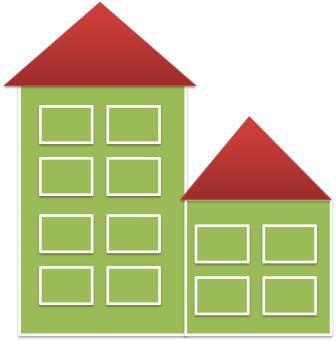GREEN BUILDINGS
Green buildings refer to environmentally sustainable buildings, buildings which do not utilise traditional resources that contribute to or increase pollution and the construction and subsequent operation minimises waste generation while maximising on sustainable practices.
The energy requirement of a building that we live or work in is around 40% (developed country) of the total energy consumption. The construction of a building is itself energy intensive. So green building is a concept that aims at minimising wasteful activities and promotes environmentally favourable technologies right from construction to the subsequent maintenance of such buildings.
A green building uses renewable energy resources such as solar power, is equipped with energy saving appliances, has systems integrated for the conservation of energy and water; it thus provides a congenial living environment.
According to the Indian Green Building Council, “A green building is one which uses less water, optimises energy efficiency, conserves natural resources, generates less waste and provides healthier spaces for occupants, as compared to a conventional building.” 
The IGBC website shows 163 certified buildings in India currently. The Indian Green Building Council was established in 2001. With the Indian construction industry growing at more than 10% per annum, it can ideally take advantage of the impetus and promote green buildings. The IGBC along with the Ministry of Commerce and Industry has also prepared the Green SEZ Guidelines.
India is already a member of the World Green Building Council- a union of national green building councils with eleven other nations.
The concept of green buildings is increasing in popularity and many cities and towns across the world are moving towards appropriate framework and policies to promote green buildings. Besides their environmental aspect, green buildings are also significant in their contribution to direct and indirect job creation in new areas of manufacturing, design, certification, maintenance, installation and also innovation and selling of new products and technology.
World’s First Green Legislative Assembly is in Chennai: The Tamil Nadu legislative assembly is built incorporating green building principles. It is the largest green building (government) in India to have achieved prestigious status of Green Building Certification (Gold rating under LEED India).
There are also some intangible and unseen benefits of green buildings by way of increased productivity of workers due to better and aesthetically improved living and working environment.
Some of the rating systems for green buildings are given below:
- LEED System (Leadership in Energy and Environmental Design), North America
- BREEAM (Building Research Establishment Environmental Assessment Method) , UK
- Green Star. Australia
- Green Globes, in 2005 by the Green Building Initiative
- GRIHA (Green Rating for Integrated Habitat Assessment), first developed by TERI in India
Reference and further reading: MNRE
Article by Mr. Puskar Pande
Green Buildings – Growing but need acceleration



Pretty nice post. I simply stumbled upon your weblog and wanted to say that I’ve really loved browsing your weblog posts. After all I’ll be subscribing to your feed and I’m hoping you write once more very soon!
This article could point out to the most important advantages of Green buildings but there are some disadvantages that must be considered. One of them is actually the costs. Green buildings are normally more expensive to build since the materials used in them are more costly; although is it correct that investors will be able to get much of their investments back over saving energy and tax credits. One has to calculate and balance the raised construction expenditures with the potential savings that can be achieved on long term.